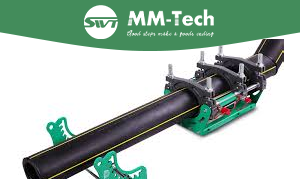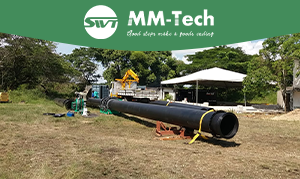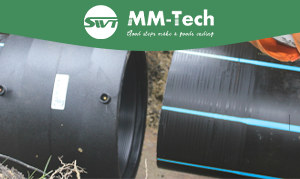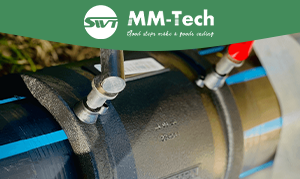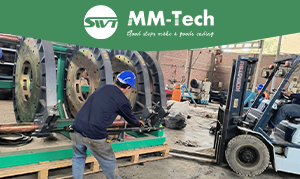Choosing the right HDPE welding machine is very important. The correct machine makes strong and dependable pipe connections. This improves both work speed and quality. Think about your project’s needs before picking a welding machine. Focus on strength, accuracy, and working well with HDPE pipes for the best outcome.
Key Takeaways
Know what your project needs to pick the right machine. Think about project size, pipe type, and welding speed for the best results.
Pick a machine that fits the size and type of pipes. This helps make strong joints and lowers the chance of errors.
Taking care of your machine is very important. Check it every month to clean it and fix settings for steady work.
Understand Your Project Requirements
To pick the right HDPE welding machine, know your project needs. This helps you find a machine that works well, saves time, and makes strong welds. Let’s look at the main things to think about.
Look at Your Project’s Size and Details
The size and difficulty of your project decide the machine you need. Big projects with many pipes may need a powerful butt fusion machine. Smaller jobs might do better with a portable plastic pipe welder.
Things to think about for project size:
How long the HDPE pipes are.
How many joints you need to weld.
How quickly the project must be done.
Tip: For big jobs, pick machines with automation to save time and effort.
Experts say project size also affects heat and time settings for welding. These settings are key to good welds, so match the machine to your project’s needs.
Match the Machine to Pipe Size and Type
Not all machines work with every pipe size or material. Make sure the machine fits the HDPE pipe size and type in your project. For example, electrofusion machines are great for small pipes, while butt fusion machines work best for big pipes.
Why this is important:
Machines like MM-Tech electrofusion adjust settings for pipe size, making accurate welds.
Matching machines make joints stronger and more reliable.
Automation in modern machines reduces mistakes and boosts efficiency.
Note: Always check the machine’s details to ensure it works with your pipes. This avoids problems and keeps things running smoothly.
Think About Environment and Power Supply
Weather and power can affect how your welding machine works. Cold or windy weather can make heating uneven. In cold places, you might need more heating time for good welds.
Challenges from the environment:
Cold weather slows welding.
Wind can cause uneven heat.
Tough machines handle harsh conditions better.
Also, check the power at your site. Some machines need steady electricity, while others work with generators. Choose a machine that fits your power setup for smooth work.
Tip: If your project is in tough conditions, get a strong and reliable machine.
By thinking about these points, you can choose the best welding machine. This makes your work faster and ensures strong welds that last.
Types of HDPE Welding Machines and Their Uses
Picking the right HDPE welding machine means knowing the types and uses. Each type has special benefits for different project needs.
Butt Fusion Welding Machines for Big Projects
Butt fusion machines are great for big jobs needing strong joints. They heat and press pipe ends together for a smooth connection. These machines are used in water systems, gas lines, and factories.
Why pick butt fusion machines?
They are precise and work well with large pipes.
Features like smart controls make work faster and easier.
Growing cities need these machines for water systems.
Tip: Automatic butt fusion machines save time and reduce mistakes. They are best for big projects.
Machine Model | Key Features | Best For Large Projects |
|---|---|---|
MM-Tech V Series | Smart tech, advanced features | High accuracy and speed |
McElroy TracStar 630 | Strong power, flexible use | Top choice for big jobs |
Ritmo Delta 500 | Easy to move, simple to use | Great for many tasks |
Electrofusion Welding Machines for Accuracy
Electrofusion machines are perfect for jobs needing accuracy. They use electricity to heat and join pipes tightly. These machines are used in water, gas, and chemical projects.
The MM-Tech electrofusion machine makes strong joints with smart controls. It avoids weak spots by keeping voltage steady. Hurner’s machines work with many materials, showing their flexibility.
Note: Electrofusion machines are best when accuracy and strength matter most.
Socket Fusion Welding Machines for Small Pipes
Socket fusion machines are made for small HDPE pipes. They are used in plumbing, irrigation, and other small jobs. The process heats and joins pipes and fittings.
Why choose socket fusion machines?
They are cheap and need little equipment.
The process is quick and easy for small tasks.
They make strong joints for small pipes.
Tip: For small jobs, socket fusion machines are affordable and simple.
Manual vs. Automatic Fusion Machines
Decide between manual and automatic machines based on your project. Manual machines need skilled workers. Automatic machines are easier with advanced features.
Feature | Manual Butt Fusion Machine | Automatic Butt Fusion Machine |
|---|---|---|
Welding Speed | 2-3 joints/hour (DN315, SDR17) | 3-4 joints/hour (DN315, SDR17) |
Cost | Lower | Higher |
Ease of Use | Needs skill | Mostly automated |
Maintenance Costs | Cheaper parts | Higher due to advanced parts |
Manual machines cost less and suit small jobs. Automatic machines are faster and reduce mistakes, making them ideal for big projects.
Note: Think about your budget and project size before choosing.
Key Features to Check in an HDPE Welding Machine
When picking the best welding machine, knowing its features is key. These features affect how well, safe, and fast your work gets done. Let’s break down the most important things to look for.
Temperature Control for Strong Welds
Good temperature control is needed for strong pipe joints. A dependable HDPE welding machine keeps heat steady, usually between 400°F and 450°F. Too much heat can weaken the weld, while too little heat makes weak joints. Clean heating plates also help spread heat evenly.
Feature | How It Affects Welds |
|---|---|
Temperature Range | 400°F to 450°F makes strong pipe bonds. |
Overheating | Weakens welds and changes pipe color. |
Underheating | Causes weak and incomplete pipe joints. |
Heating Plate Condition | Clean plates spread heat evenly for better welds. |
Tip: Choose machines with automatic heat control for easier use and better results.
Pressure Settings for Safe Welding
Safety matters when welding pipes. Machines with pressure controls help pipes join without damage. Adjustable pressure settings let you work with different pipe sizes. This keeps the process safe and makes strong connections.
Automation for Easy Use
Automation makes welding easier and faster. Automatic systems lower mistakes and improve results. Features like self-aligning clamps and digital displays make the machine simple to use. Even beginners can get good results with these tools.
Feature | Why It’s Important |
|---|---|
Easy Setup | Automatic heat control and clamps save time and effort. |
Joint Quality | Automation ensures strong and precise pipe connections. |
Note: Automated machines are best for big projects needing speed and accuracy.
Strong Build for Long Use
A tough machine lasts longer and works better. Machines made for rough conditions stay reliable over time. Strong materials and good design lower repair costs and make the machine last longer.
Tip: Read reviews to see how well the machine works in real projects.
By focusing on these features, you can find the right HDPE welding machine. This ensures your project is done safely and with high-quality results.
Budget and Cost Considerations
Renting vs. Buying: Pros and Cons
Think about how long and often you’ll need the machine. Renting is good for short projects or rare use. It costs less upfront and skips maintenance worries. But renting can cost more over time if the project is long.
Buying gives you control and saves money in the long run. You can adjust the machine to fit your needs. It’s always ready when you need it. While buying costs more at first, it avoids rental fees and supplier delays. For frequent use, owning is usually cheaper.
Tip: If you need an HDPE welding machine often, buying is better for reliability.
Balancing Initial Cost with Long-Term Value
Don’t just look at price—think about the machine’s value. Cheaper machines may cost more later due to problems. Features like automation and safety save time and reduce mistakes. Good machines also need less fixing, saving money over time.
Things to think about for cost and value:
Strong machines last longer and need fewer replacements.
Trusted brands offer better help and spare parts.
Compare the price, running costs, and maintenance needs.
A high-quality welder makes strong joints and works well. This makes it a smart choice for big projects.
Factoring in Maintenance and Repair Costs
Taking care of your machine helps it last longer. Regular maintenance keeps it working well and avoids sudden problems. Machines with easy-to-find parts and good support are cheaper to fix.
Note: A cared-for HDPE welding machine is safer and works better over time.
When planning costs, include maintenance in your budget. Good machines break down less often, saving money. Durable equipment keeps your project running smoothly and on time.
By thinking about these points, you can pick a machine that fits your budget and works well for years.
Practical Tips for Ensuring Quality and Efficiency
Training Operators for Optimal Machine Use
Training is key to using HDPE welding machines correctly. Operators should learn how the machine works and its safety features. This helps avoid mistakes and improves efficiency. Hands-on practice is important for understanding heat and pressure settings during welding.
Tools like mobile welding robots can make work easier. These robots reduce manual effort and improve weld accuracy. Cleaning stations help remove dirt that can affect welding. Simulation tools let operators test programs before starting, saving time and money.
Tip: Include real-world examples in training to prepare operators for different projects.
Adhering to Manufacturer Guidelines and Best Practices
Follow the manufacturer’s instructions for safe and effective machine use. These include temperature, pressure, and maintenance tips. Sticking to these rules lowers risks and improves performance.
Source | What It Covers |
|---|---|
OSHA Standards | Safety rules for welding at work. |
ASTM Standards | Guidelines for HDPE materials and welding methods. |
Company Policies | Rules for safe and proper welding practices. |
Standardized programs help keep results consistent. Robotic weld cells work best with these protocols for reliable outcomes.
Note: Always read the manual and follow safety rules to avoid problems.
Regular Maintenance and Calibration for Longevity
Maintenance keeps your HDPE welding machine working well and lasting longer. Clean heating plates, check pressure systems, and adjust temperature controls regularly. Predictive maintenance uses data to spot issues early and prevent breakdowns.
For example, one company reduced downtime by 20% using predictive maintenance. They tracked machine data to find problems before they happened, saving time and money.
Spatter removal systems can improve machine performance and reduce part replacements. Regular checks ensure the machine runs smoothly and avoids project delays.
Tip: Plan monthly maintenance to fix wear and tear early.
Choosing the right welding machine means thinking about your project needs. Machines made for certain pipe sizes work best with them. Features like steady heat and pressure help avoid weak welds. Newer machines with digital tools improve accuracy and keep records. Portable and strong machines are great for tough work areas.
Look into options and ask experts for advice. This helps your project go well and last a long time.
FAQ
What is the best HDPE welding machine for beginners?
Pick an automatic machine with easy-to-use features. Look for digital screens and clamps that align pipes by themselves. These make welding simpler and help avoid mistakes for new users.
How often should you maintain an HDPE welding machine?
Do maintenance every month. Clean the heating plates often. Check the pressure settings and adjust the temperature controls. This keeps the machine working well and lasting longer.
Can you use one welding machine for all pipe sizes?
No, one machine doesn’t work for every pipe size. Choose a machine that matches your pipe’s size and type. This gives better results and stronger joints.
Tip: Always read the machine’s details before starting. This helps avoid problems and keeps your project on track.


